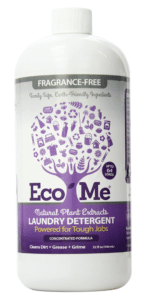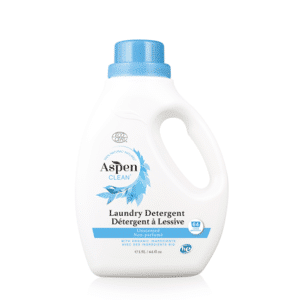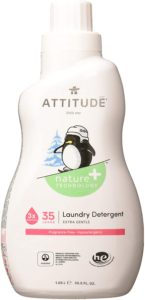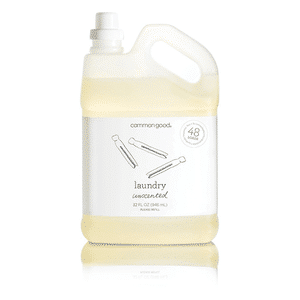Table of Contents
- A note on laundry detergent pods
- What to Watch Out for in Laundry Detergent
- The best green laundry detergents
- Dr. Bronner’s Liquid Soap, Baby Unscented
- Ingredients Matter Liquid Laundry Soap, Fragrance-Free
- Eco Me Laundry Detergent
- AspenClean Laundry Detergent, Unscented
- Attitude Little One Laundry Detergent, Fragrance Free
- Common Good Laundry Detergent, Unscented
- Popular detergent brands to avoid
- My personal experience with natural laundry detergents
- The bottom line
The irony of most laundry detergents is that they aren’t all that ‘clean.’ Many a company just takes the same old laundry liquid, adds ‘eco’, ‘green’, or ‘natural’ beside a nice picture of a child holding a flower, doubles the price, and hopes no one will notice. Not us!

The best zero-waste laundry detergent

Runner up for all-natural laundry detergent

Third pick
As with most household products these days, there are greener, more eco-friendly alternatives and we’re out to find them. Some companies making green laundry detergent are truly transparent about their ingredients and environmental policies and responsibilities.
A note on laundry detergent pods
One of the many reasons we recommend Dr. Bronner’s Liquid Soap as an excellent zero-waste laundry detergent option is the ability to refill the container. In the quest to reduce plastic consumption, some consumers assume laundry detergent pods are a green option, but buyer beware, they have a dark side for the environment. Laundry detergent pods encase their detergent in a type of water-soluble plastic called polyvinyl alcohol (PVA). Thanks to new research from scientists at Arizona State, we have mounting evidence that the plastic casing from laundry detergent pods makes its way into the environment in large amounts, which is damaging to ecosystems. For this reason, and because they are usually sold in plastic bags, we do not recommend detergent pods for the eco-conscious consumer.
What to Watch Out for in Laundry Detergent
Phosphates
Some laundry detergents still contain phosphates. These chemicals help to remove minerals and bits of stuck-on food from clothing. Unfortunately, phosphates are intense fertilizers and once they enter waterways, they cause huge, troublesome, algal blooms. In the US, phosphates are being phased out in laundry detergents, but there may still be some formulas where they linger. Make sure to check labels to ensure the detergent is free from phosphates.
Bleach
Bleach is another possible problem in some laundry detergents. If a detergent contains ‘brightener’, be wary. Companies don’t like to explicitly list bleach on their labels, given that many consumers now recognize the potential dangers of this chemical.
Dyes and Fragrances
Laundry detergents are typically formulated with dyes and perfumes or fragrances. These can be irritants and allergens, so are best avoided. If you really want your laundry to smell like lavender, rose, or other natural fragrance, add a few drops of these essential oils to your ‘fragrance-free’ or ‘free and clear’ detergent or laundry conditioner. Or sprinkle an essential oil on a wool dryer ball and throw in the dryer with your regular laundry.
Surfactants
Finally, detergents produce suds thanks to chemicals called surfactants. The surfactant nonylphenol ethoxylate (NPE) is a known endocrine disruptor as it mimics estrogen in the body. Again, as companies don’t like listing chemical names, they’ll likely just say ‘surfactant’ and leave you to do the research (assuming you won’t). Some surfactants are a little less problematic, endocrine-disruption-wise, but they’re still an environmental hazard.
Laureth-6 and laureth-7 are another concern in laundry detergents as these chemicals have high chronic toxicity to aquatic life and very high acute toxicity to aquatic life. They may also harbor impurities such as ethylene oxide and 1,4-dioxane.
The best green laundry detergents
Let’s take a look at the best green liquid laundry detergents available right now. Curious about how we rate products?
Click here to view our methodology, which at its core, is about voting with our dollars to fight climate change.

Dr. Bronner’s Liquid Soap, Baby Unscented
Highlights: Multipurpose, highly effective, fragrance-free, baby-safe liquid soap for every occasion, laundry included!
That’s right, my top pick for laundry detergent may well already be sitting in your shower caddy. Dr. Bronner’s unscented baby-friendly soap can be used for handwashing, showering, cleaning vegetables and surfaces, spraying plants to get rid of bugs, and for your laundry. Just add one third of a cup of the soap per large load and add half a cup of vinegar in the rinse cycle for naturally clean and fresh laundry. If your water is super soft, use a little less than a third of a cup.
Dr. Bronner’s soap earns an A rating from the Environmental Working Group (EWG) and is certified Vegan, USDA Organic, and Whole Foods Market Eco-Scale Rated (which means it has to fully disclose ingredients on the label and meets criteria for protecting consumers and the environment).
The only downside to this soap is that it’s not super concentrated like some dedicated laundry detergents, meaning that there’s more packaging and shipping involved in getting it to your home. That said, Dr. Bronner’s is a popular brand for zero waste stores, so check with your local store and see if you can take your old containers to refill.
As a company, Dr. Bronner’s are also a top choice, given that it has been around for more than 70 years and is still family-owned and engaged in ‘Constructive Capitalism.’ This means that the company takes its environmental and social responsibility seriously. Dr. Bronner’s invests in regenerative organic farming projects, uses 100% post-consumer recycled packaging, and is engaged in aggressive waste and water-use reduction. They are a registered B Corporation and publish annual environmental reports. Dr. Bronner’s was the first company to establish certified fair trade supply chains for coconut oil and palm oil and still strive to source their ingredients from Fair Trade suppliers in addition to treating their own employees well.
Known ingredients: Water, organic coconut oil, potassium hydroxide, organic palm kernel oil, organic olive oil, organic hemp oil, organic jojoba oil, citric acid, tocopherol.

Ingredients Matter Liquid Laundry Soap, Fragrance-Free
Highlights: Biodegradable, cruelty-free, EWG A-rated laundry detergent in recyclable packaging, safe for septic and greywater systems.
Ingredients Matter make clean cleaning products without synthetic fragrances, synthetic preservatives, dyes, parabens, phosphates, brighteners, or other nasties. The products are biodegradable and cruelty-free, and they use recyclable packaging.
This laundry liquid is PETA Cruelty-Free and Vegan certified and Leaping Bunny certified, with no animal testing. All of the company’s products are rated A and B by the EWG.
Ingredients Matter Liquid Laundry Soap is available unscented and scented with natural essential oils. Each 72 oz bottle covers 72 loads (or more, if you have soft water). This detergent works in all water temperatures and is safe for septic and greywater systems.
One nitpick: Ingredients Matter engage in a bit of unnecessary fearmongering on their website over some common ingredients in laundry detergents. Their products speak for themselves, so the company needn’t claim, for example, that certain chemicals like decyl glucoside are derived from petroleum products, with some scary-sounding in-between chemicals like toluene and propylene. This isn’t the case; decyl glucoside is plant-derived, typically from a reaction between coconut oil and corn-derived sugar alcohols. Also, there doesn’t seem to be much engagement in active Corporate Social Responsibility from this company, or at least no clear mention of it.
Known ingredients: water, potassium cocoate, potassium oleate, potassium olivate, potassium caprylate/caprate, glycerin, sodium chloride, sodium gluconate, citric acid, sodium bicarbonate.

Eco Me Laundry Detergent
Highlights: Super-concentrated green laundry detergent that’s tough on stains and dirt but gentler on skin and the environment.
Eco Me was founded in the US in 2006 by a woman whose sister was diagnosed with breast cancer, out of a desire to create less toxic, safer cleaning products. As such, all of Eco Me’s products are free from synthetic fragrances, sulfates, dyes, ethoxylates, and parabens, as well as some other common nasties found in cleaners and toiletries.
This detergent is tough on dirt and stains but is suitable for sensitive skin. It’s also available in naturally scented options. Eco Me Laundry Detergent is also free from phosphates, chlorine and formaldehyde, is greywater and septic safe, and is super concentrated, so each bottle can handle 64 loads, helping cut down on plastic.
Speaking of plastic, Eco Me repurpose the giant drums in which they get their raw materials, with the drums often ending up as rain barrels or composters. And the bottles themselves are made with BPA-free PET#1, which is one of the easiest and most cost-effective plastics to recycle. It can be turned into clothing, yoga mats, carpets, and other household goods as well as into… laundry detergent bottles.
That’s right, some of the Eco Me bottles are now made with post-consumer PET#1 plastic, so if you see a slight shade difference between two bottles, go for the one that’s a little less bright white as this may be one of their newer batches made with recycled plastic.
Eco Me also donates to charities and is otherwise engaged in community initiatives especially in their home state of California. They source supplies locally wherever possible and work with food-grade, plant-based ingredients. Their products are vegan-friendly, PETA and Leaping Bunny certified, gluten-free, and contain no synthetic preservatives, including no methylisothiazolinone benzisothiazolinone. They’re also rated highly by EcoScale and the EWG and follow Natural Products Association (NPA) guidelines.
Known ingredients: Water, Coco Glucoside (Plant-derived soap), Decyl Glucoside (Plant-derived Soap), Capryl Capryl Glucoside (Plant-derived Solubilizer), Leuconostoc (Radish Root Antimicrobial), Xanthan Gum, Natural Plant Essential Oils, Glyceryl Caprylate Caprate (Vegetable-derived Thickener), Potassium Sorbate (Food-grade Preservative).

AspenClean Laundry Detergent, Unscented
Highlights: EWG Verified eco-friendly laundry liquid from a well-respected brand and used by professional cleaners!
AspenClean’s Unscented Laundry Detergent is the only laundry liquid currently to earn a coveted Verified rating from the Environmental Working Group. This company makes a range of household cleaning products, all of which earn at least an A rating, and most a Verified rating from the EWG. And if you need reassurance that the products work, AspenClean even operate a professional cleaning service using all the company’s cleaning products!
This unscented laundry detergent is made without artificial fragrances, chlorine, parabens, sulfates and other nasty chemicals. It is 100% natural and highly effective on dirt and stains, working well at any water temperature and suitable for standard and high efficiency machines.
A couple of the ingredients are flagged as mildly problematic over at EWG, including lauryl glucoside. This is one of the better studied surfactants and is generally considered low risk to human health and the environment. It has been associated with acute concerns over aquatic toxicity but is readily biodegradable and relatively easy for municipal water treatment facilities to treat, so as long as your wastewater goes into grey water or municipal treatment waterways, it should be fine. Potassium hydroxide may also pose a small risk of skin irritation, allergies, skin damage, and respiratory effects but, again, the risk is deemed low.
The liquid detergent is concentrated, with one 64 oz bottles lasting 64 regular loads (or more if you have soft water). The bottles are made of 100% post-consumer resin plastic to eliminate the use of virgin plastic and the packaging is 100% recyclable.
AspenClean’s products, ingredients and manufacturing processes are certified as sustainable by Ecocert and certified as vegan and cruelty-free by Leaping Bunny. They use sustainable ingredients, such as organic glycerin, organic essential oils and ingredients derived from sustainably sourced palm oil (Roundtable of Sustainable Palm Oil – RSPO certified).
Known Ingredients: Decyl glucoside, lauryl glucoside, sodium gluconate, water, sodium chloride, potassium cocoate, sodium citrate, glycerin, sodium carbonate, coconut fatty acid, potassium hydroxide.

Attitude Little One Laundry Detergent, Fragrance Free
Highlights: EcoLogo certified, super simple and green laundry detergent.
Attitude Little One Laundry Detergent, Fragrance Free is certified by EcoLogo, an independent, third party consultant group, as meeting strict environmental and health requirements, with companies required to allow audits to assure their products are green. This company is also one of PETA’s Cruelty-Free Companies.
Just make sure the ingredients haven’t changed as this product used to get a D rating from the EWG as recently as 2015. This may be because the company wasn’t specific about the ingredients, though, leaving consumers (and EWG) to assume the worst over what kind of surfactants the liquid included.
Some of the products made by Attitude Little One are less eco-friendly than their laundry detergent, which is one of the reasons I’ve docked a leaf.
Known ingredients: Water, sodium coco sulfate, lauryl glucoside, sodium citrate, sodium gluconate.

Common Good Laundry Detergent, Unscented
Highlights: A few potentially problematic ingredients (mainly for aquatic life), but generally a green and safe enzyme-based laundry detergent that’s really tough on stains!
Common Good Laundry Detergent (Unscented) is one of the better options around but certainly not the best. It is Leaping Bunny certified as cruelty-free, contains plant-derived enzymes that are tough on blood and body sweat stains, among other things, and is generally green and clean, with a few exceptions.
This detergent contains the surfactant lauramine oxide, for instance, which is associated with acute aquatic toxicity, so be sure that your laundry wastewater is not heading directly into any waterways but goes instead into a treatment facility (municipal or otherwise).
They claim on their website to only use biodegradable, non-toxic ingredients on the basis of EWG ratings. A few of those ingredients, like lauramine oxide, however, are given a C rating by EWG. Given there are other ingredients that do the same thing, namely create suds, it’s strange they’ve not chosen one with an A rating.
There are no brighteners, synthetic fragrances, sulfates, dye, chlorine bleach, ammonia, or phthalates and it’s a low-sudsing formula, so contains less of the troubling surfactants that can cause environmental problems. Each 32 ounce bottle will cover 48 high efficiency loads as it is a super concentrated 3x formula.
Common Good was founded in 2011 mainly due to motivation to reduce plastic waste with a more eco-friendly refillable product range. As such, they offer refill across locations in the US, with a handy store-finder on their website. The company is also committed to using non-GMO ingredients and responsibly sourced palm oil-derived ingredients, certified sustainable by the Roundtable on Sustainable Palm Oil.
Known ingredients: water, decyl glucoside, sodium cocoamphoacetate, lauramine oxide, lactic acid, sodium benzoate, sodium gluconate, sodium citrate, tetrasodium glutamate diacetate, amylase enzyme, lipase enzyme.
Popular detergent brands to avoid
Several popular ‘green’ laundry detergents didn’t pass muster for me. For the most part this was because they contain sodium lauryl sulfate, alcohol ethoxylates (c10-16), or other chemicals of questionable merit that pose an unnecessary risk of acute aquatic toxicity or human health effects. These ‘smokestacks’ include:
- Puracy Natural Laundry Detergent, Free & Clear
- Ecover ZERO Laundry Liquid Concentrate
- Everspring Laundry Detergent, Free & Clear
- Martha Stewart Clean Laundry Detergent
- Ology 2X Laundry Liquid, Free & Clear
- Planet 2x Ultra Laundry Detergent, Free & Clear
- Planet Delicate Laundry Wash, Hypo-Allergenic
Greenshield Organic Green Shield Organic Laundry Detergent, Free & Clear – this one looks good generally but contains a potential (naturally-derived) asthma allergen, namely acacia gum.
My personal experience with natural laundry detergents
Until I realized that I could use Dr. Bronner’s liquid soap as laundry detergent, I almost exclusively used Seventh Generation Free & Clear laundry detergent. Free & Clear has been a solid performer against all manner of stains (including those related to dogs, cats, kids, birds, adults, and assorted substances – wine, coffee, chocolate, tea, blueberries, etc.).
I also like that it seems to last for months on end. This 683 mL bottle covers 66 loads but uses 60% less plastic, 50% less water, and is 75% lighter than the company’s non-concentrated 2.95 liter bottle. And, once you’re done, you can recycle the whole thing: the carton made of cardboard; the biodegradable plastic bladder insert; and the plastic cap.
Now for the downsides: Seventh Generation used to be an independent company with excellent ethics, but they were bought by Unilever in 2016. Unilever’s environmental record is terrible, so it could be argued that they’re moving in a positive direction by acquiring smaller, eco-conscious companies. Or, if you’re a cynic, you might see it as a business calculation to cash in on the eco-conscious consumer dollar through greenwashing. Either way, Seventh Generation claim to maintain their independence, albeit while making profits for Unilever.
Also, the latest iteration of this formula features a couple of troublesome chemicals, namely Laureth-6 and propylene glycol, neither of which need to be there and both of which can cause skin irritation.
Known ingredients: Aqua, Laureth-6, Glycerin, Caprylyl Decyl Glucoside, Sodium Oleate, Propylene Glycol, Protease Enzyme Blend, Sodium Chloride, Amylase Enzyme Blend, Mannanase Enzyme blend, Benzisothiazolinone, Methylisothiazolinone.
The bottom line
The bottom line when looking for an all natural laundry detergent is to prioritize simple, transparent ingredient lists, and packaging that is as zero-waste as possible, which means it can be refilled.
Your thoughts on ECO’s Free and Clear laundry detergent. That one is available in my area, without ordering online.
Hi Georgia,
I’m sorry to say that this one contains phenoxyethanol, which I’d avoid. While it’s not likely to be present in large amounts, it has been
linked to cases of eczema and life-threatening allergic reactions, and exposure in infants can cause acute nervous system dysfunction.
https://www.sfda.gov.sa/en/drug/news/pages/332-ar-01-6.aspx
https://www.ncbi.nlm.nih.gov/pubmed/11551266
https://www.ncbi.nlm.nih.gov/pubmed/26346708
That said, this is still far better than most laundry detergent out there, so unless there are highly sensitive and vulnerable people in your home, it may be the more eco-friendly option compared to ordering online. Always a tough choice!
Thanks,
Leigh
And I just learned it contains methyisothiazolinone which can be an allergen. I won’t be buying it again.
Are there any eco-safe laundry strips that are safe for greywater systems? All of those in this come in big plastic containers that are very wasteful for the environment and I live off-grid and have to haul all my recycling so I prefer compostable packaging.
Hello, thank you for sharing your research!
I have the same question as Bryce, are there any laundry strips or solid detergents that are ecologically sound? I would like to stop using enormous plastic containers even if recyclable.
Thanks again